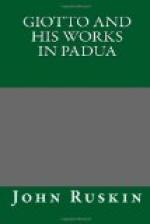* * * * *
XII.
THE VIRGIN MARY RETURNS TO HER HOUSE.
“Accordingly, the usual ceremonies of betrothing being over, he (Joseph) returned to his own city of Bethlehem to set his house in order, and to make the needful provisions for the marriage. But the Virgin of the Lord, Mary, with seven other virgins of the same age, who had been weaned at the same time, and who had been appointed to attend her by the priest, returned to her parents’ house in Galilee.” (Gospel of St. Mary, vi. 6, 7.)
Of all the compositions in the Arena Chapel I think this the most characteristic of the noble time in which it was done. It is not so notable as exhibiting the mind of Giotto, which is perhaps more fully seen in subjects representing varied emotion, as in the simplicity and repose which were peculiar to the compositions of the early fourteenth century. In order to judge of it fairly, it ought first to be compared with any classical composition—with a portion, for instance, of the Elgin frieze,—which would instantly make manifest in it a strange seriousness and dignity and slowness of motion, resulting chiefly from the excessive simplicity of all its terminal lines. Observe, for instance, the pure wave from the back of the Virgin’s head to the ground; and again, the delicate swelling line along her shoulder and left arm, opposed to the nearly unbroken fall of the drapery of the figure in front. It should then be compared with an Egyptian or Ninevite series of figures, which, by contrast, would bring out its perfect sweetness and grace, as well as its variety of expression: finally, it should be compared with any composition subsequent to the time of Raffaelle, in order to feel its noble freedom from pictorial artifice and attitude. These three comparisons cannot be made carefully without a sense of profound reverence for the national spirit[18] which could produce a design so majestic, and yet remain content with one so simple.
[Footnote 18: National, because Giotto’s works are properly to be looked on as the fruit of their own age, and the food of that which followed.]
The small loggia of the Virgin’s house is noticeable, as being different from the architecture introduced in the other pictures, and more accurately representing the Italian Gothic of the dwelling-house of the period. The arches of the windows have no capitals; but this omission is either to save time, or to prevent the background from becoming too conspicuous. All the real buildings designed by Giotto have the capital completely developed.
* * * * *
XIII.
THE ANNUNCIATION.—THE ANGEL GABRIEL.




